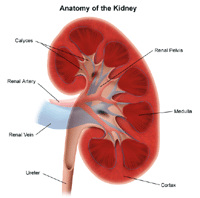Renal Vascular Disease
What is renal vascular disease?
Renal vascular disease affects the blood flow into and out of the kidneys. It may cause kidney damage, kidney failure, and high blood pressure.
Vascular conditions include:
-
Renal artery stenosis (RAS). This is a narrowing or blockage of an artery to the kidneys. It may cause kidney failure and high blood pressure. Smokers have a greater risk of getting RAS. It’s most common in men between the ages of 50 and 70. High cholesterol, diabetes, being overweight, and having a family history of heart disease are also risk factors for RAS. High blood pressure is both a cause and a result of RAS.
-
Renal artery thrombosis. This is a blood clot in an artery that supplies the kidney. It may block blood flow and cause kidney failure.
-
Renal vein thrombosis. This is the formation of a clot in a vein to the kidney.
-
Renal artery aneurysm. This is a bulging, weak area in the wall of an artery to the kidney. Most are small and don’t cause symptoms. Renal artery aneurysms are rare and are often found during tests for other conditions.
-
Atheroembolic renal disease. This happens when a piece of plaque from a larger artery breaks off and travels through the blood. This blocks small renal arteries. This disease is becoming a common cause of kidney problems in the older adults.
Renin is a strong hormone that raises blood pressure. Decreased blood flow to the kidney(s) from renal vascular disease may cause too much renin to be made. This can lead to high blood pressure.
What causes renal vascular disease?
The cause of renal vascular disease will depend on the specific condition involved. The main causes are:
-
Atherosclerosis
-
Injury
-
Infection
-
Inflammatory or other underlying disease
-
Surgery
-
Tumor
-
Aneurysm
-
Pregnancy
-
Certain medicines
-
Birth defect
Who is at risk for renal vascular disease?
Risk factors for renal vascular disease include:
-
Older age
-
Female
-
Atherosclerosis
-
High blood pressure, especially new high blood pressure in an older person
-
Smoking
-
High cholesterol
-
Diabetes
What are the symptoms of renal vascular disease?
Symptoms of renal vascular disease vary depending on the type of disease and degree of involvement present.
Renal Artery Stenosis
-
High blood pressure that doesn’t get better with 3 or more medicines.
-
Increased urea (a waste product made by the kidneys) in the blood.
-
Unexplained kidney failure.
-
Sudden kidney failure when first taking an angiotensin-converting enzyme (ACE) inhibitor for blood pressure and/or heart treatment
Renal Artery Thrombosis
-
Sudden onset of side pain between the ribs and the upper border of the hip bone (flank pain), pain and tenderness
-
Fever
-
Blood in the urine
-
Nausea and vomiting
-
Sudden decrease in kidney function
-
High blood pressure
A gradual or incomplete clot may not cause symptoms and go undetected
Renal Artery Aneurysm
-
There are often no symptoms·
-
High blood pressure
-
Tear in aneurysms may cause flank pain and blood in the urine
Atheroembolic Renal Disease
-
Skin lesions or red or purple color of the skin.
-
Discolored areas of the toes and feet
-
Kidney failure
-
Belly pain
-
Diarrhea
-
Confusion
-
Weight loss
-
Fever
-
Muscle aches
Renal Vein Thrombosis
Slow Onset
-
Most often causes no symptoms
Sudden Onset
-
On-going severe flank pain with spasms at times
-
Soreness over the kidney, between the ribs and the backbone
-
Decreased kidney function
-
Blood in urine
The symptoms of renal vascular disease may look like other medical conditions or problems. Always talk with your healthcare provider for a diagnosis.
How is renal vascular disease diagnosed?
Your healthcare provider will review your medical history and do a physical exam. Other tests may include:
-
Arteriogram (or angiogram). This is an X-ray image of the blood vessels used to check for aneurysm, narrowing, or blockages. A dye (contrast) is injected through a thin, flexible tube placed in an artery. This dye makes the blood vessels visible on X-ray.
-
Duplex ultrasound. This test is done to check blood flow and the structure of the renal veins and arteries. The term “duplex" refers to the fact that 2 modes of ultrasound are used. The first takes an image of the renal artery being studied. The second mode checks the blood flow.
-
Renography. This test is used to check the function and structure of the kidneys. It is a type of nuclear radiology procedure. This means that a tiny amount of a radioactive substance is used during the test to help view the kidneys.
-
Magnetic resonance angiography (MRA). This test uses a combination of magnetic resonance imaging (MRI) technology and intravenous (IV) contrast dye to see blood vessels. Contrast dye causes blood vessels to appear solid on the MRI image. This lets the healthcare provider see the blood vessels.
What is the treatment for renal vascular disease?
Your healthcare provider will figure out the best treatment for you based on:
-
How old you are
-
Your overall health and medical history
-
How sick you are
-
How well you can handle specific medicines, procedures, or therapies
-
How long the condition is expected to last
-
Your opinion or preference
Treatment will also vary depending on the type of renal vascular disease that is present.
Renal Artery Stenosis
Medical Treatment
- Blood pressure lowering medicines other than ACE inhibitors may be used to treat high blood pressure.
- Medicines to lower cholesterol may be prescribed for atherosclerosis.
- Treatment of related medical conditions such as diabetes.
Surgical Treatment
- Endovascular procedures such as angioplasty (the opening of a renal artery using a balloon or other method) or placement of a stent (a tiny, expandable metal coil placed inside an artery to keep the artery open).
- Open surgery to bypass the blocked renal artery.
Renal Artery Thrombosis
In acute cases, thrombolytic (clot-busting) medicine may be infused into the renal artery for several hours to several days to break up the clot.
Surgery to remove the clot or bypass the artery may be done in some situations.
Renal Artery Aneurysm
Treatment of a renal artery aneurysm depends on symptoms and the size and location of the aneurysm. Some smaller aneurysms may not be treated, but may be watched for growth or problems.
Surgery may be used to treat larger, tearing, or growing aneurysms. It may also be used for aneurysms causing lack of blood flow to the kidney and high blood pressure, and aneurysms causing symptoms.
Because of the increased risk for rupture (bursting), a renal artery aneurysm in a pregnant woman or a woman of childbearing age will generally be treated with surgery.
Atheroembolic Renal Disease
Treatment may include medicines to lower cholesterol, blood pressure, and treat other related conditions, such as diabetes.
Diet and exercise are urged to lower blood pressure. Avoid foods high in fats and salt.
Surgical treatment may include:
-
Endovascular procedures such as angioplasty (the opening of a renal artery using a balloon or other method) or placement of a stent (a tiny, expandable metal coil placed inside an artery to keep the artery open).
-
Open surgery to bypass the blocked renal artery.
Renal Vein Thrombosis
Renal vein thrombosis is generally treated with an anticoagulant, which keeps the blood from clotting. They may be given intravenously (IV) for several days, then given by mouth for a few weeks or more.
What are the complications of renal vascular disease?
In time, renal vascular disease can lead to kidney failure. This may call for dialysis or a kidney transplant. Other complications include:
-
Heart disease
-
Stroke
-
Heart attack
-
Heart failure
-
Damage to blood vessels
-
Loss of vision
When should I call my healthcare provider?
If your symptoms get worse or you have new symptoms, tell your healthcare provider.
Key points about renal vascular disease
-
Renal vascular disorders are a variety of conditions affecting the blood flow into or out of the kidneys.
-
Conditions that affect the blood flow through the kidneys can affect the function of the kidneys and should be treated promptly to prevent permanent damage or other complications.





